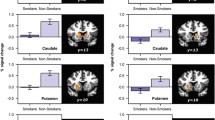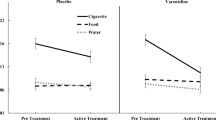Abstract
Rationale
Brain reward pathways implicated in addiction appear to be less reactive in regular drug users; behavioural manifestations may include decreased sensitivity to natural reinforcers.
Objectives
This study aimed to replicate earlier findings of abstinence-associated incentive motivation deficits in smokers and to determine whether these can be reversed with nicotine in the form of lozenge.
Methods
One hundred forty-five smokers were each tested twice, once after receiving nicotine, and once after receiving placebo lozenge in counterbalanced order. Participants completed various tests of incentive motivational functioning: a measure of subjective enjoyment, the Snaith–Hamilton pleasure scale (SHAPS); a simple card sorting task, the card arranging reward responsivity objective test (CARROT) with and without financial incentive; the modified emotional Stroop test; a cue-reactivity task; and a novel reaction time task to explore effects of signals of reward, the incentive motivational enhancement of response speed task.
Results
Compared with performance during abstinence (placebo condition), nicotine was associated with: higher self-reported pleasure expectations on the SHAPS; enhanced responsiveness to financial reward on the CARROT in smokers who smoked 15 or more cigarettes a day; and greater interference from appetitive words on the Stroop task.
Conclusions
These results are generally consistent with contemporary neurobiological theories of addiction and suggest that short-term smoking abstinence is associated with impaired reward motivation which can be reversed with nicotine.



Similar content being viewed by others
References
Al-Adawi S, Powell J (1997) The influence of smoking on reward responsiveness and cognitive functions: a natural experiment. Addiction 92:1773–1782
Baker TB, Morse E, Sherman JE (1987) The motivation to use drugs: a psychobiological analysis of urges. In: Rivers PC (ed) The Nebraska symposium on motivation: alcohol use and abuse, vol 34. University of Nebraska Press, Lincoln, pp 257–323
Bozarth MA (1991) The mesolimbic dopamine system as a model reward system. In: Willner P, Scheel-Kruger J (eds) The mesolimbic dopamine system: from motivation to action. Wiley, pp 301–330
Brody AL, Mandelkarn MA, London ED, Childress AR, Lee GS, Bota RG et al (2002) Brain metabolic changes during cigarette craving. Arch Gen Psychiatry 59:1162–1172
Brody AL, Mandelkarn MA, Lee G, Smith E, Sadeghi M, Saxena S et al (2004) Attenuation of cue-induced cigarette craving and anterior cingulate cortex activation in bupropion-treated smokers: a preliminary study. Psych Res 132:183–184
Caggiula AR, Donny EC, White AR, Chaudhri N, Booth S, Gharib MA et al (2001) Cue dependency of nicotine self-administration and smoking. Pharmacol Biochem Behav 70:515–530
Childress AR, Mozley PD, McElgin W, Fitzgerald J, Reivich M, O’Brien CP (1999) Limbic activation during cue-induced cocaine craving. Am J Psychiatry 156:11–18
Corrigal WA, Franklin KBJ, Coen KM, Clarke P (1992) The mesolimbic dopamine system is implicated in the reinforcing effects of nicotine. Psychopharmacology 107:285–289
Dagher A, Bleicher C, Aston JAD, Gunn RD, Clarke PBS, Cummings P (2001) Reduced dopamine D1 receptor binding in the ventral striatum of cigarette smokers. Synapse 42:48–53
David SP, Munafo MR, Johansen-Berg H, Smith SM, Rogers RD, Matthews PM, Walton RT (2005) Ventral striatum/nucleus accumbens activation to smoking-related pictorial cues in smokers and nonsmokers: a functional magnetic resonance imaging study. Biol Psychiatry 58:488–494
Dawkins L, Acaster S, Powell JH (2006a) The effects of smoking and abstinence on experience of happiness and sadness in response to positively-valenced, negatively-valenced and neutral film clips. Addict Behav (in press) available online from 7th July 2006
Dawkins L, Powell JH, West R, Powell J, Pickering A (2006b) A double-blind placebo controlled experimental study of nicotine: II-effects on response inhibition and executive functioning. Psychopharmacology (in press)
Depue RA, Collins PF (1999) Neurobiology of the structure of personality: dopamine, facilitation of incentive motivation and extraversion. Behav Brain Sci 22:491–569
Gamberino WC, Gold MS (1999) Neurobiology of tobacco smoking and other addictive disorders. Psychiatr Clin North Am 22:301–312
Goldstein RZ, Volkow ND (2002) Drug addiction and its underlying neurobiological basis: neuroimaging evidence for the involvement of the frontal cortex. Am J Psychiatry 159:1642–1652
Gray JA, Young AM, Joseph MH (1997) Dopamine’s role. Science 278:1548–1549
Gross TM, Jarvik ME, Rosenblatt MR (1993) Nicotine abstinence produces content-specific Stroop interference. Psychopharmacology 110:333–336
Heatherton TF, Kozlowski LT, Frecker RC, Fagerström KO (1991) The Fagerström test for nicotine dependence: a revision of the Fagerström Tolerance Questionnaire. Br J Addiction 86:1119–1127
Hughes JR, Hatsukami D (1986) Signs and symptoms of tobacco withdrawal. Arch Gen Psychiatry 43:289–295
Hughes JR, Frederiksen LW, Frazier M (1978) A carbon monoxide analyzer for measurement of smoking behaviour. Behav Ther 9:293–296
Hyland Q, Rezaishiraz H, Giovino G, Bauer JE, Cummings K (2005) Over-the-counter availability of nicotine replacement therapy and smoking cessation. Nicotine Tob Res 7:547–555
Jarvis MJ, Pedoe H, Feyerabend C, Vesey C, Saloojee Y (1987) Comparison of tests used to distinguish smokers from non-smokers. Am J Public Health 771435–1438
Johnsen BJ, Thayer JF, Laberg JC, Absjornsen AE (1997) Attentional bias in active smokers, abstinent smokers and nonsmokers. Addict Behav 22:813–817
Keenan RM, Henningfield JE, Jarvik ME (1995) Pharmacological therapies: nicotine addiction. In: Miller NS, Gold MS (eds) Pharmacological therapies for alcohol and drug addiction. Marcel–Dekker, New York, pp 239–264
Lubman DI, Yucel M, Pantelis C (2004) Addiction, a condition of compulsive behaviour? Neuroimaging and neuropsychological evidence of inhibitory dysregulation. Addiction 99:1491–1502
Martin-Sölch C, Magyar S, Künig G, Missimer J, Schultz W, Leenders KL (2001a) Changes in brain activation associated with reward processing in smokers and non-smokers: a positron emission tomography study. Exp Brain Res 139:278–286
Martin-Sölch C, Chevalley AF, Kunig G, Missimer J, Magyar S, Mino A et al (2001b) Changes in reward-induced brain activation in opiate addicts. Eur J Neurosci 14:1360–1368
McClernon FJ, Hiott FB, Huettel SA, Rose JE (2005) Abstinence-induced changes in self-report craving correlate with event-related FMRI responses to smoking cues. Neuropsychopharmacology 30:1940–1947
Munafo M, Mogg K, Roberts S, Bradley BP, Murphy M (2003) Selective processing of smoking-related cues in current smokers, ex-smokers and never-smokers on the modified Stroop task. J Psychopharmacol 17:310–316
Olausson P, Jentsch JD, Taylor JR (2004) Repeated nicotine exposure enhances responding with conditioned reinforcement. Psychopharmacology 173:173–178
Payne TJ, Smith PO, Sturges LV, Holleran SA (1996) Reactivity to smoking cues: mediating roles of nicotine dependence and duration of deprivation. Addict Behav 21:139–154
Pickering AD (2004) The neuropsychology of impulsive antisocial sensation seeking: From dopamine to hippocampal function? In: Stelmack RM (ed) On the psychobiology of personality: essays in honour of Marvin Zuckerman. Elsevier, pp 455–478
Pickering A, Brady P, Jeffs J, Jones L (2001) Personality correlates of the responses to associative mismatch and to stimuli associated with reward or punishment. Paper presented at the meeting of the Experimental Psychology Society, London
Powell JH, Dawkins L, Davis R (2002a) Smoking, reward responsiveness, and response inhibition: tests of an incentive motivational model. Biol Psychiatry 51:151–163
Powell JH, Tait S, Lessiter J (2002b) Cigarette smoking and attention to signals of reward and threat in the Stroop paradigm. Addiction 97:1163–1170
Powell JH, Pickering AD, Dawkins L, West R, Powell JF (2004) Cognitive and psychological correlates of smoking abstinence and predictors of successful cessation. Addict Behav 29:1407–1426
Rahman S, Zhang J, Corrigall WA (2003) Effects of acute and chronic nicotine on somatodendritic dopamine release of the rat ventral tegmental area: in vivo microdialysis study. Neurosci Lett 348:61–64
Russell MAH (1976) Tobacco smoking and nicotine dependence. In: Gibbins RJ, Israel Y, Kalant H, Popham RE, Schmidt, W, Smart RG (eds) Research advances in alcohol and drug problems, vol 1. Wiley, New York, pp 1–48
Rusted JM, Caulfield D, King L, Goode A (2000) Moving out of the laboratory: does nicotine improve everyday attention? Behav Pharmacol 11:621–629
Robinson TE, Berridge KC (1993) The neural basis of drug craving: an incentive-sensitisation theory of addiction. Brain Res Rev 18:247–291
Robinson TE, Berridge KC (2000) The psychobiology and neurobiology of addiction: an incentive-sensitisation view. Addiction 95:S91–S117
Salamone JD (1994) The involvement of nucleus accumbens dopamine in appetitive and aversive motivation. Behav Brain Res 61:117–133
Snaith RP, Hamilton M, Morley S, Humayan A, Hargreaves D, Trigwell P (1995) A scale for the assessment of hedonic tone: the Snaith–Hamilton pleasure scale. Br J Psychiatry 167:99–103
Spiga R, Schmitz J, Day JII (1998) Effects of nicotine on methadone self-administration in humans. Drug Alcohol Depend 50:157–165
Swartz SH, Cowan TM, Klayman JE, Welton MT, Leonard BA (2005) Use and effectiveness of tobacco telephone counselling and nicotine therapy in Maine. Am J Prev Med 29:288–294
Volkow ND, Li TK (2004) Drug addiction: the neurobiology of behaviour gone awry. Nat Rev Neurosci 5:963–970
Volkow ND, Wang G-J, Fowler JS, Logan J, Gatley SJ, Hitzemann R et al (1997) Decreased striatal dopaminergic responsiveness in detoxified cocaine-dependent subjects. Nature 386:830–833
Volkow ND, Wang G-J, Fowler JS, Hitzeman R, Angrist B, Gatley SJ et al (1999) Association of methylphenidate-induced craving with changes in right striato-orbitofrontal metabolism in cocaine abusers: implications in addiction. Am J Psychiatry 156:19–26
Volkow ND, Fowler JS, Wang G-J, Swanson, JM (2004a) Dopamine in drug abuse and addiction: results from imaging studies and treatment implications. Mol Psychiatry 9:557–569
Volkow ND, Fowler JS, Wang G-J (2004b) The addicted human brain viewed in the light of imaging studies: brain circuits and treatment strategies. Neuropharmacology 47:3–13
Waters AL, Shiffman S, Sayette MA, Paty JA, Gwaltney, CJ, Balabanis MH (2003) Attentional bias predicts outcome in smoking cessation. Health Psychol 22:378–387
West RJ, Russell MAH (1985) Pre-abstinence nicotine intake and smoking motivation as predictors of cigarette withdrawal symptoms. Psychopharmacology 87:334–336
Acknowledgments
This research was funded by the National Institute of Drug Abuse (grant code 3527427). Thanks are due to Glaxo Smith Kline for providing the nicotine and placebo lozenges.
Author information
Authors and Affiliations
Corresponding author
Rights and permissions
About this article
Cite this article
Dawkins, L., Powell, J.H., West, R. et al. A double-blind placebo controlled experimental study of nicotine: I—effects on incentive motivation. Psychopharmacology 189, 355–367 (2006). https://doi.org/10.1007/s00213-006-0588-8
Received:
Accepted:
Published:
Issue Date:
DOI: https://doi.org/10.1007/s00213-006-0588-8




